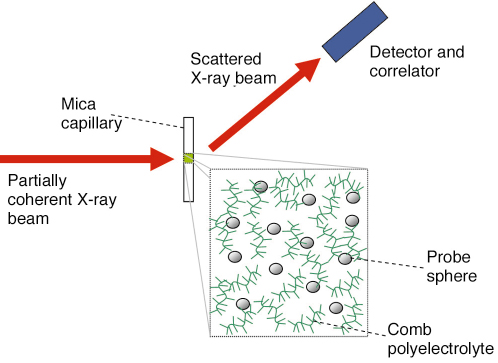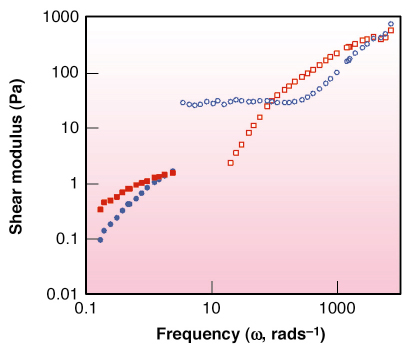- Home
- Users & Science
- Scientific Documentation
- ESRF Highlights
- ESRF Highlights 2005
- Soft Condensed Matter
- Microrheology of Polymeric Solutions using X-ray Photon Correlation Spectroscopy
Microrheology of Polymeric Solutions using X-ray Photon Correlation Spectroscopy
Polymeric solutions exhibit a wide range of viscoelastic properties which are crucially important for their biological behaviour and a number of industrial applications e.g. muscular contractions, blood clotting and colloidal stabilisation. Microrheology is a field which considers the measurement of the viscoelasticity of materials as a function of length scale. Recently, a number of new microrheological techniques have been developed with numerous advantages over conventional rheological measurements; they are sensitive to a wider range of frequencies (~ 10-4 -106 Hz), they only require minute quantities of polymer (10 µL) and they apply extremely small forces (pN), which enables the examination of delicate biological molecules [1].
 |
|
Fig. 58: X-ray photon correlation spectroscopy microrheology examines the viscoelasticity of polymeric solutions using the motion of embedded probe spheres. The polymer solutions were contained in capillaries (~ 10 µL) and mixed with 0.5 µm silicon probe spheres. The incident X-ray beam is partially coherent and the scattering volume must be restricted to the size of the coherence volume for the technique to work. An auto-correlator device is used to calculate g(2)(t), the temporal auto-correlation function of the scattered intensity, at various momentum transfers. |
Based on X-ray Photon Correlation Spectroscopy (XPCS), we have developed a new microrheology technique to probe the dynamics of opaque materials in solution. XPCS exploits a partially coherent X-ray beam to quantify the motion of materials by monitoring fluctuations of the scattered intensity (Figure 58). In XPCS microrheology, probe spheres are embedded in the material of interest and the mean square displacement of the spheres is measured as a function of time and momentum transfer. The motion of the probes is sensitive to the viscoelasticity of the surrounding medium and can be quantitatively analysed to provide the shear moduli as a function of frequency (Figure 59).
XPCS microrheology was performed at the TROIKA beamline ID10A to probe the viscoelasticity of biomimetic comb polyelectrolytes [2] and gellan (a bacterial polysaccharide). The X-rays are mainly scattered by the probe particles, e.g. colloidal silica, embedded in the samples. A wide range of materials can be examined by XPCS microrheology, since colloidal probes form stables phases in many polymeric and biological solutions. The XPCS measurements of the viscoelasticity of polystyrene sulphonate comb polyelectrolytes at low concentrations (Figure 59) were in good agreement with video particle tracking microrheology results on similar samples. The side-chains of the combs cause a dramatic effect on the viscoelasticity of the polyelectrolytes, inducing entangled dynamics immediately above the semi-dilute overlap concentration, and the viscosity is a strong function of the polymer concentration (![]() ~ c1.5) [2]. Such comb materials are interesting because of possible applications in tissue engineering as a treatment for osteoarthritis. With gellan the elasticity of the network of double helical junctions is observed in the dominant contribution of the elastic shear modulus (G’ > G’’) at lower frequencies (Figure 59). Gellan is used as a thickener in food materials such as yoghurts, drinks and sauces.
~ c1.5) [2]. Such comb materials are interesting because of possible applications in tissue engineering as a treatment for osteoarthritis. With gellan the elasticity of the network of double helical junctions is observed in the dominant contribution of the elastic shear modulus (G’ > G’’) at lower frequencies (Figure 59). Gellan is used as a thickener in food materials such as yoghurts, drinks and sauces.
 |
|
Fig. 59: The viscoelastic shear moduli for opaque comb polyelectrolyte (filled symbols) and gellan (open symbols) solutions calculated from XPCS microrheology experiments. The circles show the elastic shear moduli (G’) and squares the dissipative shear moduli (G’’). |
In conclusion, XPCS microrheology offers a new scattering technique to probe the dynamic properties of biological and soft-condensed matter materials. It has a large dynamic range, modest requirements on sample volume and does not suffer from constraints on sample opacity, which restrict analogous optical techniques (e.g. optical tweezers).
References
[1] T.A. Waigh, ‘Microrheology of complex fluids’, Rep. Prog. Phys. 68, 685-742 (2005).
[2] A. Papagiannopoulos, C.M. Fernyhough, T.A. Waigh, Accepted for publication in J. Chem. Phys..
Principal Publication and Authors
A. Papagiannopoulos (a), T.A. Waigh (a), A. Fluerasu (b), C.M. Fernyhough (c) and A. Madsen (b), J. Phys.: Condens. Matter, 17, L279-285 (2005).
(a) Department of Physics and Astronomy, University of Leeds (U.K.)
(b) ESRF
(c) Department of Chemistry, University of Sheffield (U.K.)



